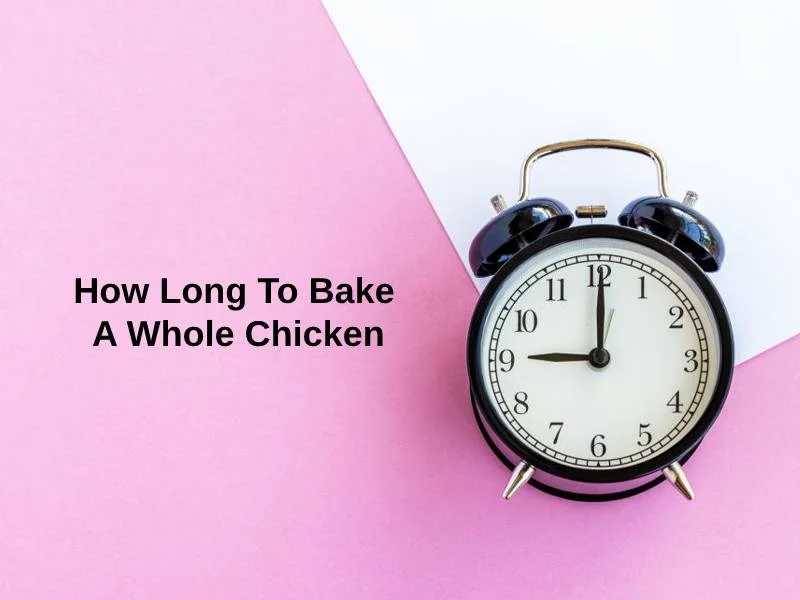Exact Answer: Approximately 45 – 60 Minutes
Chicken, being the most versatile and easiest main ingredient can be used to prepare numerous delicious dishes for one’s family and friends. Roast chicken is extremely juicy and delicious. One can buy, prepare and bake a whole chicken at home as they are comparatively cheaper than the plastic trays of bundled chicken parts.
To cook a whole chicken, knowing exactly how long to cook and bake it is the key. The chicken is said to be done when a meat thermometer reads 165 degrees F in the thigh muscle or until drumsticks (part of chicken leg connected to the thigh) move easily in sockets.

How Long To Bake A Whole Chicken?
| Weight | Duration For Baking |
| 2.5 – 3 pound | Approx. 1 hour |
| 3.5 – 4 pound | Approx. 1 hour 30 minutes |
| 4.5 – 5 pound | Approx. 2 hours |
The chicken is thoroughly baked when it reaches an internal temperature of 165 degrees F i.e. 74 degrees C. One can easily understand the internal temperature of the meat by inserting a meat thermometer into the inner thighs of the chicken, close to the bone but not touching the bone.
As a general rule, a whole chicken is baked for 20 minutes per pound and also for an extra 15 minutes. A 1.5kg chicken will be perfectly roasted and baked after 1 hour 20 minutes at 190 degrees C.

For a more succulent chicken, one can take it out of the fridge one hour before cooking to bring it up to room temperature. It is important for one to know that the chicken continues to cook even after it is taken out of the oven. Making a foil tent to cover the chicken and letting it rest for about 10 minutes will result in an even juicier and tastier chicken.
Why Does It Take So Long To Bake Chicken?
It is said that if one can bake chicken, one can make dinner over and over again. This is a simple recipe with salt, pepper, and olive oil, but so versatile.

Steps for making perfectly baked whole chicken are as follows:-
- Preheating the oven.
- Rinsing and pat drying the entire chicken with a paper towel.
- Combining olive oil, melted butter, and lemon juice together and rubbing all over the chicken, under its skin, and inside the cavity.
- Seasoning the chicken outside and inside with salt, pepper, and parsley. One must ensure to be generous while seasoning it.
- If one wants to maximize the garlic taste, rub the minced garlic all over the chicken and under the skin.
- One can also stuff the garlic head into the chicken cavity along with sprigs of rosemary, thyme, or any other herb and squeezed lemon halve.
- Roasting the chicken by baking it inside the oven for an appropriate duration as per the weight of the chicken.
- Broil until golden and crispy.
- Remove from the oven, cover with foil and allow it to stand for at least 10 minutes before serving.
- Drizzle with pan juices and remaining lemon half cut into wedges or slices.
The baking duration will entirely depend upon the size of the bird. Allowing an additional resting time of 10 minutes will help in keeping all the delicious juices intact before slicing.
Conclusion
Chicken takes longer to cook because they have higher fat content and density inside them. The presence of bone also increases the baking time by some more minutes.
Resting period for few minutes after baking is quite important as the chicken continues to cook as it rests This period allows the meat to come up to the right temperature and gives the juices, that have been pulled into the center of the bird while it was in the oven time, to redistribute to the surface of the meat.
It is important to keep in mind that the USDA says that as long as all parts of the chicken have reached a minimum temperature of 165 degrees F, it is safe to eat. The color of the meat does not indicate doneness. The USDA further explains that even fully cooked poultry can sometimes show a pinkish tinge in the meat and its juices.